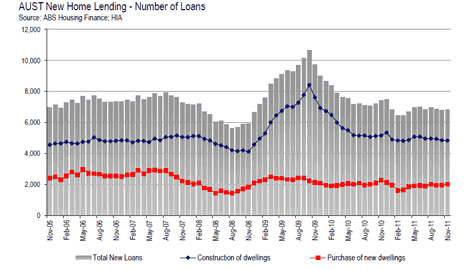Mortgage approvals up amid increased first-home buyer and fixed-rate home loan demand
Increased first-home buyer activity and demand for fixed-rate mortgages were the two key trends to emerge from solid November ABS housing finance figures released today.
The figures, which include the impact of the November 1 rate cut, reveal that the number of owner-occupier mortgages increased 1.4% to just under 47,000 – the eighth consecutive monthly increase in mortgage approvals.
By state, the figures for owner-occupier finance were mixed, continuing the divide evident in 2011, noted Westpac.
“NSW outperformed, up 4.2%, with the announced changes to stamp duty arrangements from the start of 2012 bringing demand forward,” Westpac says.
“The mining state of WA strengthened, up 0.9%. However, Victoria weakened, down 0.2%, with the state facing a sizeable increase in supply. Queensland remained disappointing, up 0.9%, which was insufficient to reverse falls over the previous two months,” says Westpac.
There was a pick-up in the investment sector, with fixed loans for investment housing rising 2.2% to $6.6 billion while the total number of loans purchased for new dwellings increased by 2% over the month.
Macquarie senior economist Brian Redican described the November data as “encouraging and a step in the right direction”.
He expects the two successive interest rate cuts and the prospect of more cuts to come in 2012 to deliver further boosts to the housing sector in the months to come.
“I think it does have to have a positive impact. These numbers don't reflect those cuts yet and it will have to take a few more months for that to flow through,” Redican says.
First-home buyers’ share of mortgage approvals (excluding refinancing) increased to 16.1% in November from 15.7% in October.
“This is the highest first-home buyer share of total approvals since January 2010 and shows that improving housing affordability is generating some moderate first-home buyer activity,” noted David Cannington from ANZ Research.
Cannington expects first-home buyers’ share of the market to continue to increase over the coming months due to further weakening in house prices and lower mortgage rates – December housing finance figures will factor in both the November and December rate cuts as well as improved interest rate sentiment.
The other key finding from the November data was the growing demand for fixed-rate loans, which increased to 11.1% in November from 10.6% in October to be at the highest proportion since June 2008.
“Attractive fixed mortgage rates and ongoing financial market uncertainty continued to drive an increase in fixed rate lending,” Cannington says.
Dean Rushton, chief operating officer of mortgage broker Loan Market, expects the eight months of consecutive mortgage growth to continue while consumers act upon the November and December rate cuts.
“Consumers will likely remain confident in the housing finance market, with the strong possibility of a rate cut in February,” he says.
“This should fuel a significant number of approvals in the coming months, which will stimulate many struggling sectors in the economy.”
Mortgage approvals in NSW were up 4.9% from October 2011, and 9.4% for the year.
“In NSW we’re seeing a significant demand brought forward by first-home buyers acting before the 2011 deadline for the stamp duty exemption,” Cannington says.
There was a 2% increase in loans for the purchase of new homes with a 5.6% rise in NSW, an 8.4% increase in Queensland, a 13.4% in South Australia, a 20.9% increase in the Northern Territory, and a 17.5% increase in the ACT.
The number of loans for new housing fell by 8.5% in Victoria, 3.3% in Western Australia, and 8.9% in Tasmania. Over the three months to November 2011 lending for new housing was down in all states and territories except for Tasmania, WA and Queensland.

HIA chief economist Harley Dale says there is “a modest revival underway in the established lending market, which now extends to five rises in six months”.
“New home lending has yet to join the ride,” he says.
The combined number of loans for construction/purchase of a new dwelling was effectively flat in November 2011 (up 0.3%) to be down by 8% when compared to the same month in 2010,” Dale says.
“The second half of 2011 saw a renewed trend decline in new home lending, a concerning situation which further highlights the risk of new housing starts approaching GFC-like levels once more,” Dale adds.
Masters Builders Australia chief economist Peter Jones also noted the ongoing weakness in loans for construction and purchase of new dwellings.
“The key finance indicator released today by the ABS shows that demand for new dwellings remains flat, despite indications of a pick-up in commitments for the purchase of established dwellings.
“The housing market is beginning to pick itself off the floor but the number of finance commitments remains weak by historical standards as consumer caution and euro turmoil work against the upswing.
“The two recent rate cuts in November and December will help, but Master Builders believes the Reserve Bank still needs to do more to boost confidence and encourage a recovery in residential building.